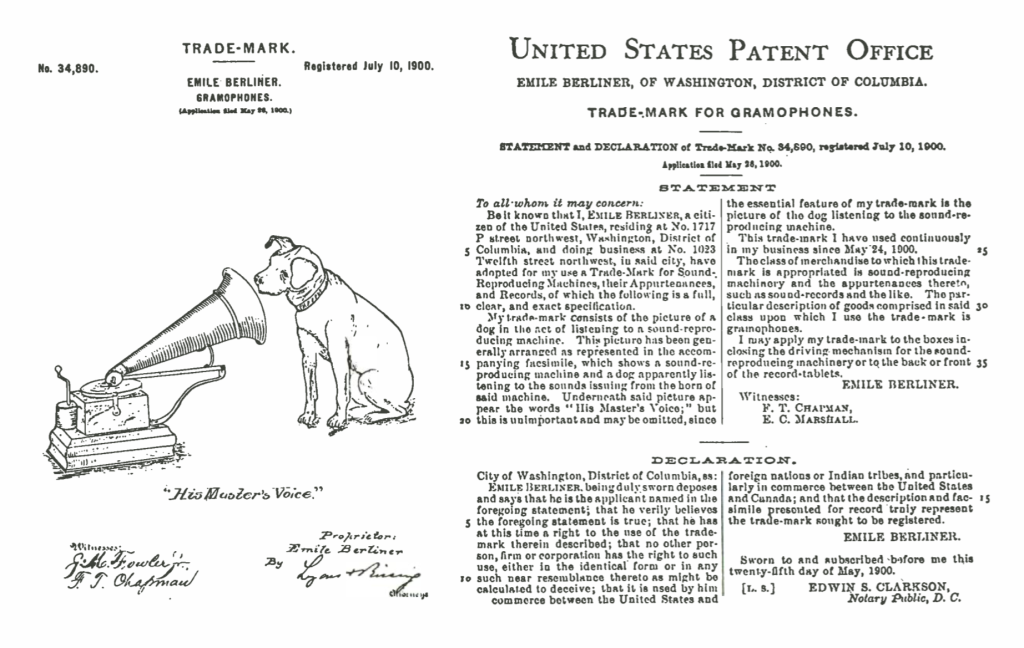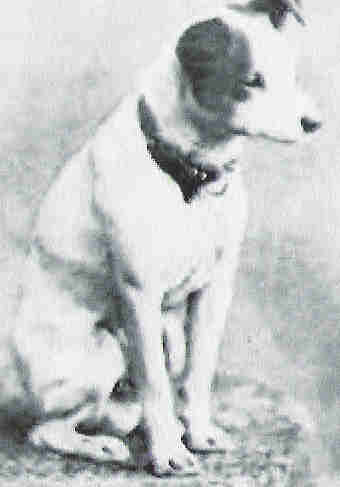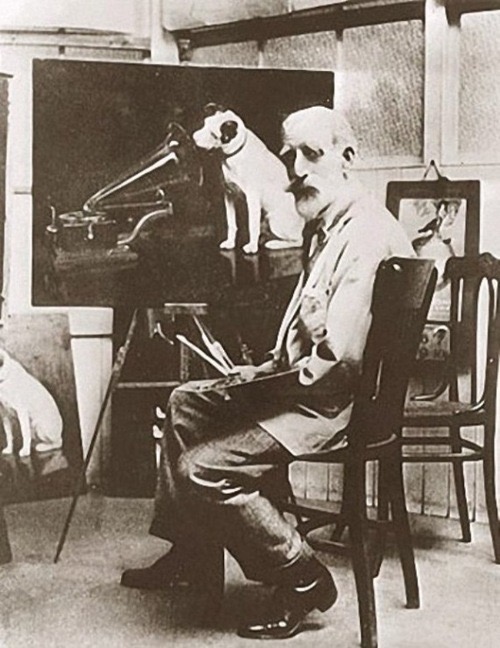December 2023
His master’s voice is one of the most memorable corporate phrases and logos. You know, the image of a little dog listening to an old-time gramophone. I grew up associating it with RCA Victor records, with a vague awareness that before that it appeared on the Victor Talking Machine Company’s Victrola records. But it wasn’t until I saw a video about JVC, which invented the VHS videotape, that I learned that the phrase and logo were also used by that corporation (JVC stands for Japan Victor Company) as well as the British HMV (yes, originating from His Master’s Voice). I also learned that the logo originated in England in 1899, where it began as a somewhat different painting.


Francis James Barraud was an English painter. When his older brother, Mark, died in 1887, his dog Nipper was sent to live with Francis. It happened that Francis had purchased an Edison Commercial Phonograph. He noticed how Nipper would sit close to the horn speaker, with his head turned and his ears pricked, listening to the mysterious sounds. The image stuck with him, but there is a false history about the dog sitting on his brother’s coffin, listening to a recording of his master’s voice. The real story follows.
Nipper died in 1895, so in 1898, when Francis had the idea of painting the dog listening to the phonograph, he had to use a photograph of the dog for his model. He painted an image of the dog listening to his cylinder phonograph on a table. Barraud proceeded to register for a copyright on the painting, but he had no success in having it exhibited at the Royal Academy. When he showed it to various publishers, the only offer was to purchase it for five pounds (equivalent to $670 in 2023).
Barraud took the painting to the Edison-Bell offices in London, where manager James Hough rejected it, saying, “Dogs don’t listen to phonographs.” No doubt Hough later rued the day he passed on what would become one of the most recognized trademarks of the 20th century.
We only know what the painting originally looked like because Barraud had it photographed for his copyright. In 1972, factory worker and gramophone enthusiast Frank Andrews learned that the original painting had been “registered” and realized that a photograph of it might be on file among the “Works of Art” copyright applications in the Public Records Office in London. He found it in a box that hadn’t been opened in over 70 years.

After the rejection from Edison-Bell, a friend of Barraud’s then suggested that he brighten up the picture, using a brass horn rather than the dark one he had painted. Barraud went to The Gramophone Company, which was just over a year old and had disc phonographs with brass horns. He asked them to lend him one to paint from.
Luckily, the American William Barry Owen was the manager, acting as the agent for Emile Berliner, the German inventor of the gramophone record. Owen asked if the painting was for sale, and if so whether Barraud would be willing to paint over the Edison cylindrical phonograph with one of their disc gramophones. Barraud agreed, altered the painting, and sold The Gramophone Company the painting for 50 pounds and the transfer of its copyright for another 50 pounds. So he netted the 2023 equivalent of about $13,400.

The logo and the phrase “His master’s voice” appeared in advertising literature and sometimes on company stationery. Emile Berliner visited the British office in May 1900, saw the painting, and soon registered it as a trademark over in America. Eldridge Johnson soon took over Berliner’s rights to the trademark for his new Victor Talking Machine Company and began heavily promoting it.

The British company began using the logo and phrase more in 1909, introducing it on its record labels, and, because it lost the trademark on “Gramophone”, replacing “Gramophone Monarch Record” and “Gramophone Concert Record” on the labels with the caption “His Master’s Voice”.


By 1913, the painter Francis Barraud was in some financial difficulty. The company asked him to make an exact copy of the painting, which he agreed to do for 35 pounds. It was sent to the Victor Company in the USA. In 1914, three directors of the Victor Company commissioned more copies from Barraud, each for 35 pounds.
Alfred Clark, who was a cameraman and director at Edison’s first film studio and later joined The Gramophone Company and became the managing director, befriended Barraud. He later recalled, “He was a man of great personal charm, and was beloved by many devoted friends…during the war, in spite of his years, he volunteered to serve his country, and was appointed to a regular position in the recruiting department of the Army. The prolonged hours of attendance and thoroughly hard work undoubtedly affected his health seriously.”
In 1919, The Gramophone Company and the Victor Talking Machine Company agreed jointly to pay Barraud an annuity of 250 pounds per year. In 1921, The Gramophone Company established the HMV company to sell disc records and later radios and televisions, naturally using the logo to accompany the trademarked phrase.
Barraud ended up painting 24 replicas of his original painting in total, including 12 more commissioned from him in 1922 by the Victor Company at 35 pounds each. He even made one free copy that was so exact that he painted in the old phonograph and then painted it over with the gramophone, ensuring the finished work would more closely match the original. That oh-so-exact copy eventually made its way to the Capitol Records tower in Hollywood, while the original hangs at the Gloucester Place headquarters of EMI, which was formed from The Gramophone Company, HMV, and the Columbia Gramophone Company in 1931.
Francis Barraud died in late August 1924, a few months after the two gramophone companies had increased his annuity to 350 pounds. Alfred Clark shared, “His gentle, kindly ways endeared him to all of us. He made his voyage through his life, modestly and simply, leaving behind to his sorrowing friends a feeling of great loss.”
The high regard Barraud had earned is reflected in that, after his death, the companies learned he had been sending 100 pounds of his annuity each year to his sister, who was living at an old age home in Staffordshire. The British and American record companies immediately continued that payment each year until her death in 1929.
In 1927, the Victor Talking Machine Company incorporated a Japanese branch that would become JVC. RCA (Radio Corporation of America) gained control of the phrase and logo in 1929 when it purchased Victor and its foreign subsidiaries. Thus little Nipper and his gramophone continued to grace the products of multiple corporations for decades to come.
Today, if you go to Kingston upon Thames in England, you’ll find Nipper Alley, with a familiar logo on its sign. That’s because down that alley is a parking lot behind a branch of Lloyds Bank. Way back in 1895, that lot was the garden of a house, and when little Nipper died, he was buried there under a mulberry tree.


And what about the man who immortalized Nipper? Francis Barraud’s remains rest eleven miles away, in a neglected overgrown grave in Hampstead Cemetery in greater London.


However, the best remembrance of him are the countless reproductions of his greatest work. As he put it, “It was certainly the happiest thought I ever had.”













i grue up listening to RCA records
and always wondered who the little dog was and his name .
thanks for helping me find out.
PS. Nipper,you became my best friend
RIp.love always